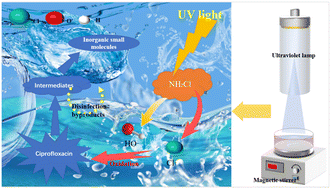The degradation of ciprofloxacin in the UV/NH2Cl process: kinetics, mechanism, pathways and DBP formation†
Abstract
In this work, UV/NH2Cl was utilized to remove ciprofloxacin (CIP) from water and the formation of disinfection by-products (DBPs) following disinfection was investigated to determine its applicability and safety. It was demonstrated that the degradation of CIP in UV/NH2Cl was significantly more effective than that in NH2Cl oxidation alone or UV alone. The presence of NOM (0–8 mg L−1), CO32− (0–8 mM), and NO3− (0–8 mM) inhibited CIP degradation with kobs,CIP from 0.030 to 0.012, 0.017, and 0.020 min−1, respectively. In contrast, the NH2Cl concentration (0.25–2 mM) and Cl− (0–8 mM) promoted the degradation of CIP with kobs,CIP increasing from 0.022–0.054 min−1 and 0.030–0.034 min−1. HCO3− had dual effects on the degradation of CIP. pH slightly affected the degradation of CIP by UV/NH2Cl in near neutral pH range but greatly inhibited it under strong acidic and alkaline conditions. The reaction rate constant of CIP and HO˙ was calculated to be kHO˙,CIP = 3.0 × 109 M−1 s−1 and the contribution of the reactive chlorine species and reactive nitrogen species to CIP degradation was much greater than that of HO˙. Intermediate products of CIP were identified and analyzed to propose 3 possible degradation pathways. The formation of DBPs with NH2Cl disinfection was lower than that with NaClO disinfection after the oxidation of UV/NH2Cl. Briefly, this study provides much useful information for a better understanding of the UV/NH2Cl process for water treatment.

- This article is part of the themed collection: Environmental Science: Water Research & Technology Recent HOT Articles

 Please wait while we load your content...
Please wait while we load your content...